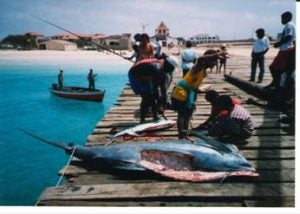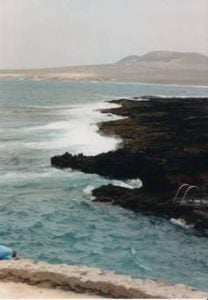Investigating variation

For the past twenty years, I have conducted extensive field work on the Cabo Verdean archipelago which consists of nine inhabited islands (Brava, Fogo, Santiago, Maio, Boa Vista, Sal, São Nicolau, São Vicente and Santo Antão) that have traditionally been clustered into two main groups, the leeward islands to the South and the windward islands to the North.
This apparently seamless geographic division conceals much variation within these two clusters and within each island. Each island was settled in different periods of history by different populations of Portuguese settlers (among other Europeans who came later) and African slaves. The islands of Santiago and Fogo were settled as early as 1461 and the island of Sal as late as 1831.
The mix between Portuguese, Mande and West-Atlantic languages makes Cabo Verdean Creole a rich and innovative language. This mixing of linguistic features combined with distinct settlement histories for each island and a diglossic situation where Cabo Verdean Creole continues to co-exist with Portuguese make for a complex variation continuum. Such variation presents a real descriptive challenge for all linguists involved in the documentation of Cabo Verdean Creole.
The acute awareness of such variation and the fact that some varieties of Cabo Verdean were better studied than others led me to conduct field work on all nine inhabited islands of the archipelago between 1997 and 2008. My first corpus was built by conducting interviews, surveys, and using picture books and the mini-film The Pear Story in order to document and describe all nine varieties of the Cabo Verdean language. This corpus provided field data that resulted in my first book The Syntax of Cape Verdean Creole (2002), focusing on the varieties spoken in the leeward islands. The corpus I have gathered over the years provides a large database of naturalistic speech data that are reflective of the varieties spoken on all nine islands of the archipelago.
The objectives of my field work are manyfold: A primary goal is to give a voice and representation to the varieties spoken on all nine islands allowing linguists to document the language as accurately as possible and in all its complexity. My belief is that a thorough documentation of an oral language allows for sounder analyses when using different theoretical frameworks. Another objective is to explore how a different history of settlement involving diverse European and African populations has affected lexically and morpho-syntactically the make-up of each variety. A long-term goal is to connect the Creole language spoken on the islands to other varieties and other Creoles spoken on the African mainland, in the Gulf of Guinea and all the way to the Caribbean, following the pioneering work of Frank Martinus (1996) who first highlighted the possible genetic relationship between Cabo Verdean Creole and Papiamentu. The ultimate objective is to use the documentation and linguistic analyses that field work data provide to unveil the full complexity of the language, demonstrate its status as a full-fledged language and help promote its officialization in Cabo Verde. This is a struggle that Cabo Verdean and foreign activists in Cabo Verde and the diaspora have led for more than three decades and that this kind of work hopes to support.
In search of the founding populations of Cabo Verde
The fact that each island was settled in different periods of history by different populations of Portuguese settlers (among other Europeans who came later) and African slaves led to a long-term collaboration with a team of geneticists and linguists (geneticists Paul Verdu, Noah Rosenberg, Trevor Pemberton, Ethan Jewett and linguists Sérgio Costa and Valentin Thouzeau) with the objective of reconstructing the ancestry of Cabo Verde founding populations.
Between 2010 and 2018, we collected speech data and DNA samples on all nine islands of the archipelago. Our first paper conveyed the results of our analysis for the island of Santiago and is entitled “Parallel Trajectories of Genetic and Linguistic Admixture in a Genetically Admixed Creole Population”, co-authored with Paul Verdu [first author], Ethan Jewett [first author], Trevor Pemberton and Noah Rosenberg. This paper appeared in Current Biology in 2015. Future papers will convey the results of the data collected on the other eight islands.
Some field sites visited between 1997 and 2008
Island of Boa Vista: Cabeça dos Tarafes, João Galego, Povoação Velha, Sal Rei
Island of Brava: Cachaço, Furna, Nossa Senhora do Monte, Nova Cintra, Santa Barbara
Island of Fogo: Brandão, Chã das Caldeiras, Curral Grande, Forno, Ponta Verde, São Filipe
Island of Maio: Calheta, Figueira, Vila do Maio
Island of Sal: Palmeira, Pedra de Lume, Santa Maria
Island of Santiago: Assomada, Calheta de São Miguel, Chão Bom, Cidade Velha, Espinhu Branco, Picos, Praia, São Domingos, Tarrafal
Island of Santo Antão: Paul, Porto Novo, Ribeira Grande
Island of São Nicolau: Juncalinho, Preguiça, Ribeira Brava, Tarrafal Island of São Vicente: Calhau, Mindelo, São Pedro, Salamansa










